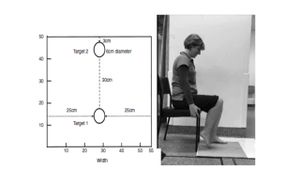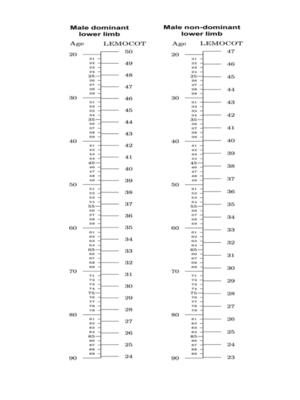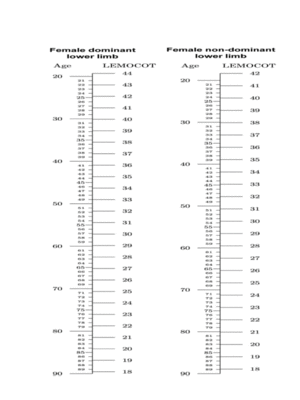Lower Extremity Motor Coordination Test (LEMOCOT)
Introduction:[edit | edit source]
Lower Extremity Motor Coordination Test was developed as an easy, yet effective tool to clinically assess, measure, and evaluate the deficits in Lower Limb Motor Coordination [1] [2], specifically spatial and temporal accuracies [2], in conditions such as stroke, spinal cord injuries, ataxia, Parkinson’s disease, schizophrenia or other psychiatric illnesses. With the LEMOCOT, individuals are required to move at their maximal capacity. [2]
The standard reference values were determined using healthy individuals, categorizing them into age and gender. [1]
It is able to detect motor coordination disturbances after stroke. It also gives a strong indicator of participation capabilities. [1]
It is interesting to note that LEMOCOT scores differentiated between stroke patients who were discharged to long-term care compared to other types of living environments. [1]
Technique:[edit | edit source]
There are two red targets, 6 cm in diameter each, which are placed 30cm apart in a vertical direction. The patient, sitting in a comfortable position with their knees flexed at 90 degrees, is asked to shift their leg back and forth to accurately touch the red target, as quick as they can, and as many times as they can, in 20 seconds. Every accurate touch of the target counts as a single score in the test.
The individual needs to maintain the accuracy of respective touches, and the quality, smoothness, and integrity of their movement. A familiarization trial is permitted before the number of touched targets are counted.[1][2][3]
Obtaining the LEMOCOT Score[edit | edit source]
There are a few possible ways to determine the LEMOCOT score, as illustrated by different researchers. [1]
Yildrin et al ( ) took the highest score from three trials of the LEMOCOT post-operatively, while Desrosiers et al ( ) took the mean of two trials of stroke patients. [1]
The various scoring methods were not clinically significant, but did show test-retest reliability, which indicates that any method could be used. It is noted hat the average of a greater number of trials can reduce errors in overall scoring. [1]
However, when compared to healthy individuals, only one trial was needed for reliable values. [1]
Implications[edit | edit source]
It is seen that LEMOCOT scores differentiated between people with and without stroke, compared to the age and gender predicted normal values for healthy individuals, and between paretic and non-paretic individuals. [1]
It is seen that the LEMOCOT can be a predictor walking ability. However, since the LEMOCOT generally measures motor coordination, and walking ability involves components such as balance, strength, range of motion, muscular tone, proprioception, and posture, the LEMOCOT cannot be properly used as a measure of walking ability and speed. In fact, stroke recovery patterns would be quite different for every individual. [1]
It is assumed that LEMOCOT scores differentiated between individuals of differing motor recovery. However, even between similar and differing recovery stages, LEMOCOT scores greatly differentiated. It was concluded that motor coordination solely could not differentiate individuals at differing stages of motor recovery. [1]
Another implication could be the learning effect of the LEMOCOT. Although a familiarization attempt is allowed for the LEMOCOT, it is possible that there may be a learning effect. Individuals may improve by practice de to the effect of reduced anxiety or possibly familiarization with the process or the testing environment. When practice effects aren't consider, incorrect interpretations may be made, and the effects of cognitive decline may be missed [2]
Applicability to Stroke[edit | edit source]
Prior to using the LEMOCOT with stroke patients, certain measurement properties need to be in place. [1]
Deficits in motor coordination after stroke are seen to depend on the level of functional and motor recovery, and the time elapsed since the stroke incident. Therefore, the level of deficit should be assessed at different stages of the stroke rehabilitation. The LEMOCOT should detect differences between the paretic and non-paretic sides as well. [1]
It is seen that major differences, between healthy and impaired individuals, were only noticed when comparing the performance of the paretic limb, where as the performance of the non-paretic limb did not have a significant difference in the scoring. The mean score of the paretic limb represented 51% of the outcome of the non-dominant limb for healthy individuals. [1]
Validity and Reliability:[edit | edit source]
The convergent construct validity was shown by significantly high correlations with physical and functional tests. Construct validity can be evaluated by comparing outcomes of groups differing in some characteristics or abilities. [1]
The divergent validity was shown by a reduced association with cognitive or visual perceptual tests. [1]
Evidence:[edit | edit source]

Test-retest reliability in stroke population[edit | edit source]
Intraclass correlation (ICC) >0.97
Construct validity p<0.0001
ICC values (dominant and non-dominant limbs) 0.90<ICC<0.99[1]
Validity and Reliability in Autosomal recessive spastic ataxia of Charlevoix-Saguenay (ARSACS) population[edit | edit source]
ICC 0.92 - 0.97[5]
Normative Values for LEMOCOT[6]
References[edit | edit source]
- ↑ 1.00 1.01 1.02 1.03 1.04 1.05 1.06 1.07 1.08 1.09 1.10 1.11 1.12 1.13 1.14 1.15 1.16 1.17 de Menezes KK, Scianni AA, Faria-Fortini I, Avelino PR, Faria CD, Teixeira-Salmela LF. Measurement properties of the lower extremity motor coordination test in individuals with stroke. Journal of Rehabilitation Medicine. 2015 Jun 5;47(6):502-7.
- ↑ 2.0 2.1 2.2 2.3 2.4 Menezes KKP, Avelino PR, Scianni AA, Faria-Fortini I, Faria CDCM, Nascimento LR, Teixeira-Salmela LF. Learning Effects of the Lower Extremity Motor Coordination Test in Individuals with Stroke. Physical Medicine and Rehabilitation - International. 2017:4(1):1-3.
- ↑ Menezes KP, Nascimento LR, Pinheiro MB, Scianni AA, Faria CD, Avelino P, Faria-Fortini I, Teixeira-Salmela LF. Lower limb motor coordination is significantly impaired in ambulatory people with chronic stroke: a cross-sectional study. J Rehabil Med. 2017 Apr 1;49:322-6.
- ↑ Kwan MS, Hassett LM, Ada L, Canning CG. Relationship between lower limb coordination and walking speed after stroke: an observational study. Brazilian journal of physical therapy. 2019 Nov 1;23(6):527-31.
- ↑ Lessard I, Lavoie C, Côté I, Mathieu J, Brais B, Gagnon C. Validity and reliability of the LEMOCOT in the adult ARSACS population: a measure of lower limb coordination. Journal of the Neurological Sciences. 2017 Jun 15;377:193-6.
- ↑ Pinheiro MB, Scianni AA, Ada L, Faria CD, Teixeira-Salmela LF. Reference values and psychometric properties of the lower extremity motor coordination test. Archives of physical medicine and rehabilitation. 2014 Aug 1;95(8):1490-7.








